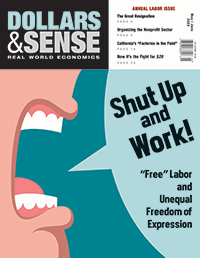Power, Wages, and Inequality
A recent government report has an unexpected focus--power in the workplace.
On March 7, 2022, the U.S. Department of the Treasury issued a report titled, "The State of Labor Market Competition." It is not what one might expect from the U.S. government. It is apparent that something is unusual when the first chapter is "Theories of Labor Market Power," and the word "power" appears 15 times in the executive summary, 12 times in the introduction, and too many times to count in the body of the report. Power, after all, is generally absent from mainstream myths of how labor markets work.

May/June 2022 issue.
The basic message of the report is that: "...The American labor market is characterized by high levels of employer power." And:
...A careful review of credible academic studies places the decrease in wages at roughly 20% relative to the level in a fully competitive market. In some industries and occupations, like manufacturing, estimates of wage losses are even higher.
At the center of employers' power is that many firms operate as monopsonies in the labor market. A pure monopsony is the only buyer in a market, but a very large employer, or a few very large employers, in a market can operate in a monopsonistic manner. Like monopolies that can largely set the prices of what they sell, monopsonists can largely set the prices--wages in the context of the report--of what they buy.
Good examples would be a Walmart store or an Amazon warehouse in a comparatively rural area, where employment options are relatively limited. Indeed, the message of the report is illustrated by a 2018 report in The Economist:
In the years since Amazon opened its doors in Lexington County [South Carolina], annual earnings for warehouse workers in the area have fallen from $47,000 to $32,000, a decline of over 30%.
Employers' power, however, is exhibited in several ways beyond the direct setting of wages.
Power in the Labor Market
Power in the labor market (and other economic and political realms as well) is often a matter of what alternatives are available. For example, workers' power is limited in relation to their employer when they have very few employment alternatives or when they lack information about alternatives. On the other hand, employers' power is enhanced when they have alternative ways of organizing production or when they can limit the alternatives available to their workers.
Examples from the report of how power exists or is created in U.S. labor markets include the following:
- Employers can outsource (sometimes internationally) parts of their operations. Creating separations among various production activities in this way is called "fissuring." A common example in recent decades has been firms' outsourcing of janitorial work.
- Employers can demand that their employees sign "noncompete" agreements, which prevent them from working for a competitor firm if they leave their current job. Examples of other such agreements demanded by employers are training repayment agreements, nonsolicitation agreements, and nondisclosure agreements. All of these sorts of agreements limit employees' ability to change jobs--i.e., limit their alternatives.
- Employers can establish mandatory arbitration agreements, preventing workers from legal recourse to rectify violations of labor laws, antitrust laws, or employment terms.
- Employers can often adopt "skill-based technical changes"--that is, substituting machines for workers. Because particular skills are often the basis of workers' bargaining power, their power can be undermined by such employer action, or even by the threat, explicit or implicit, of such action. Employers can discourage or even formally prohibit workers from exchanging information about their wages, restricting workers' knowledge of their alternatives within or outside the firms.
- Mergers, either by reducing the number of firms and jobs in an area or simply by increasing the dominance of the one resulting firm, can alter the labor market in favor of the employers. (See box.)
The high cost for workers of moving to take advantage of better job markets elsewhere also reduces their power, without any direct action by employers.
All of these factors limit workers' alternatives or are possible because workers' alternatives are already limited, leaving them with little power to resist employers' actions. Each adds to the asymmetry of power between employers and workers.
Labor Markets and Economic Inequality
As compared to the textbook fantasy of "free markets," including labor markets where employers and employees enter on equal footing, the reality described in the Treasury Department's report makes one of the foundations of economic inequality very clear. Keeping workers' wages down--by 20%--means keeping employers' incomes (and their wealth) up.
It appears, then, that labor markets operate in tandem with other, more frequently cited sources of rising inequality--the form globalization has taken, the decline of labor unions (which employers actively pursue), new technology, rising monopoly power (along with rising monopsony power), and lack of government enforcement of economic regulations.
Economic inequality is the result of a combined set of factors and cannot be fully understood in terms of a single cause. The operation of labor markets, however, is an important one of those factors.
